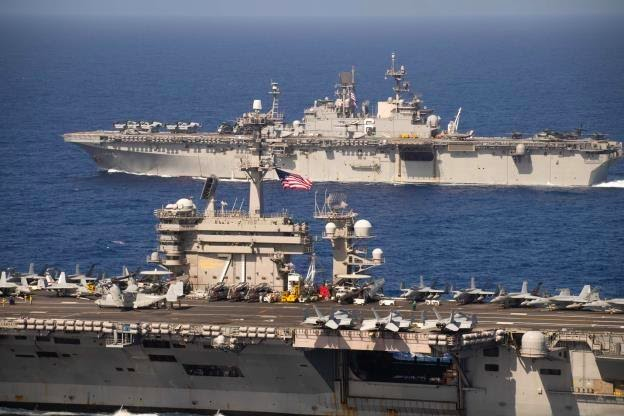Water Wars: Duterte Disdains Detente, Departs Defense Deal
Winter has been a relatively quiet time in the South Pacific as policy priorities shifted in response to the novel coronavirus outbreak, but the Philippines’s stated intent to depart the U.S. defense pact may destabilize the regional balance yet again.

Published by The Lawfare Institute
in Cooperation With

On Feb. 11, Philippine President Rodrigo Duterte announced his intent to terminate the Visiting Forces Agreement (VFA) that governs the legal status of U.S. military personnel on short-term deployments in the Philippines and sets consistent parameters for U.S. military personnel’s in-country operations. Duterte has long harbored suspicions about the U.S. military presence in his country and claimed a day prior to the announcement that the U.S. was using its presence in the Philippines to secretly store nuclear weapons. The U.S. and the Philippines originally signed the VFA in 1998; it currently enables approximately 300 joint operations per year, each of which would have to be negotiated individually in the absence of any agreement.
The U.S. response to Duterte’s announcement was mixed: President Trump characterized the decision as “fine,” while some defense officials expressed concern about the future of the U.S.-Philippines relationship. Reactions in Duterte’s government were equally mixed. Philippine Defense Secretary Teodoro Locsin had warned on Feb. 6 that scrapping the VFA would undermine national security. And on March 2 the Philippine Senate asked for a Philippine Supreme Court review of Duterte’s power to unilaterally make or break international agreements. On Feb. 28, Philippine Ambassador to the U.S. Jose Manuel Romualdez said that diplomats are in discussions on a possible successor agreement. The existing VFA will remain in effect for 180 days after Duterte’s declaration of intent was received by U.S. officials.
In Regional News
Weeks after the conclusion of an extended standoff between Indonesian and Chinese vessels in the Natuna Islands, another, three-way, struggle is taking place between ships from Malaysia, Vietnam and China. This latest standoff was triggered by a Malaysian drillship moving into an oil block that falls within the continental shelf claims made by Vietnam and Malaysia, as well as within China’s expansive nine-dash line. The ships involved in the standoff now include Vietnamese fishing boats, elements of the Malaysian navy and some of China’s most capable Coast Guard vessels. The Asia Maritime Transparency Institute (AMTI) has reconstructed the opening weeks of the standoff here.
On Jan. 25, littoral combat ship USS Montgomery conducted a freedom of navigation operation (FONOP) through the contested Spratly Islands in the South China Sea, passing within 8.5 nautical miles of Fiery Cross Reef (Mandarin: “Yongshu Reef”; Tagalog: “Kagitingan Reef”), one of China’s artificial islands. Three days later, on Jan. 28, Chinese officials issued a scathing response, decrying what they saw as the “evil intentions” with which the FONOP had been conducted.
On Jan. 13, Chinese Coast Guard (CCG) vessel 5204 docked in Manila for the first friendly port call by a CCG ship. 5204 carried supplies for those displaced by the eruption of the Taal volcano in Batangas province. After leaving Manila, 5204 steamed for the Natuna Islands, where it joined the ongoing Malaysia-Vietnam-China standoff on Feb. 16.
The South China Morning Post has obtained footage of a near collision between U.S. and Chinese warships during a 2018 FONOP in the Spratly Islands, home to several of China’s artificial islands in the South China Sea. The video shows Chinese sailors preparing for an impact between their vessel and the USS Decatur, although the ships ultimately did not collide and passed within a few yards of each other.
In Naval News
Although civilian shipping has slowed dramatically due to the COVID-19 outbreak, the U.S. 7th Fleet has maintained a high degree of cooperative activity in the southeastern Pacific theater. On Jan. 13, the USS America joined with Japan Maritime Self-Defense Force ship JS Kunisaki for sea and air drills, including personnel exchanges and F-35B operations demos. On Jan. 20, U.S. naval patrol and reconnaissance aircraft joined counterparts from Australia, Japan, South Korea and New Zealand for exercise Sea Dragon 2020, which involved competitive patrol and anti-submarine drills. Sea Dragon lasted 10 days, and the Royal New Zealand Air Force took top honors in the scored drills. On Jan. 25, Japanese and U.S. helicopter crews executed a joint rescue of five American aircrew who survived the crash of their MH-60S helicopter in the Philippine Sea. On Feb. 15, the Theodore Roosevelt Carrier Strike Group and the America Expeditionary Strike Group conducted joint exercises and maneuvers in the Indo-Pacific as a unitary Expeditionary Strike Force. From Feb. 17 to 21, a U.S. Los Angeles-class submarine participated in Japan’s annual Submarine Competition, designed to test crew proficiencies across the spectrum of submarine warfare. On Feb. 24, more than 77 units from the U.S. and Japan participated together in exercise Resilient Shield 2020, a computer-based operation with a focus on ballistic missile defense. And on Feb. 29, the U.S. and Japanese naval forces kicked off a bilateral advanced warfighting training exercise; U.S. 7th Fleet participants include at least two guided-missile destroyers and two guided-missile cruisers.
On Jan. 26, the U.S. Navy’s first Triton unmanned aircraft systems arrived in the Pacific. The two Triton aircraft are currently assigned to Unmanned Patrol Squadron 19 at Anderson Air Force Base in Guam.
Analysts suggest that the new Ford class of aircraft carriers could be fitted with anti-missile lasers and other next-generation, high-power-draw systems. The nuclear reactors on the USS Gerald R. Ford and subsequent carriers have an output capacity of more than 100 megawatts—three times that of those on board their Nimitz-class predecessors. The Gerald R. Ford is currently undergoing post-delivery trials, which are scheduled to conclude in 2021. Its first successor, the USS John F. Kennedy, was christened in December and is now being fitted for a 2024 delivery.
The first details on the new U.S. warhead-development program have been released. Dubbed W93, the project is intended to be a next-generation weapons system rather than an iteration on the current W88 and W76 warheads, which were introduced in 1989 and 1978, respectively. Leaks obtained by Defense News imply that W93 will be compatible with the Trident II submarine-launched missile currently in use.
The U.S. Navy has revealed that it is approximately 9,000 sailors short of full strength, a shortage that increased by almost 50 percent in the past year. The Navy has requested $33.9 billion for personnel in the 2021 budget ($2.1 billion more than last year) in hopes of remedying the shortfall.
The proposed 2021 U.S. Navy budget also includes funding for 850 anti-ship missiles, spurred by concerns about China’s continued emphasis on shipbuilding. Navy Times breaks down the extensive weapons wishlist by volume and type here. And the U.S. Marine Corps is also eyeing anti-ship weaponry: On March 5, the Corps submitted written testimony to Congress declaring anti-ship capabilities to be its top ground modernization priority.
The U.S. Navy has determined that the cost of maintaining the original four littoral combat ships (LCSs)—Freedom, Independence, Fort Worth and Coronado—has become too high to justify their continued use and intends to decommission them. Designed and operated as testing platforms for the LCS concept, the four ships would have cost the Navy an estimated $1.8 billion in repairs and upgrades over the next five years.
Analysis
At AMTI, Renato Cruz de Castro dives into President Duterte’s decision to end the VFA between the Philippines and the United States. Cruz de Castro discusses whether the choice is another product of Duterte’s famously mercurial temperament or a sign of larger policy shifts in the region. He leans toward the latter, suggesting that Duterte is genuinely worried that a close relationship with the U.S. will pin his country between two superpowers as area tensions slowly escalate.
In the South China Morning Post, Ankit Panda argues that Indonesia should step into a leadership role in the region by taking a stronger stance against Chinese territorial encroachment. Panda’s view is that Indonesia could tip the balance against China’s legal claims if Jakarta takes a firm position on the South China Sea dispute that aligns with its smaller neighbors and the United States.
John Power delivers a much more sobering perspective in the South China Morning Post, arguing that the U.S. and its allies may have already lost the “battle” for the South China Sea. He notes that an increasing number of experts and analysts consider China to have taken a clear advantage in every strategic category from number of vessels to geographic presence. Power cautions that this strategic disadvantage makes it extremely difficult for the U.S. to apply leverage or to credibly assert its stances.





